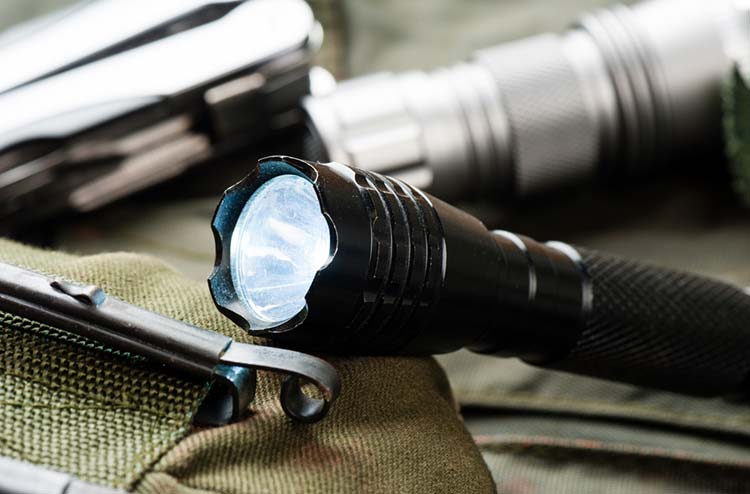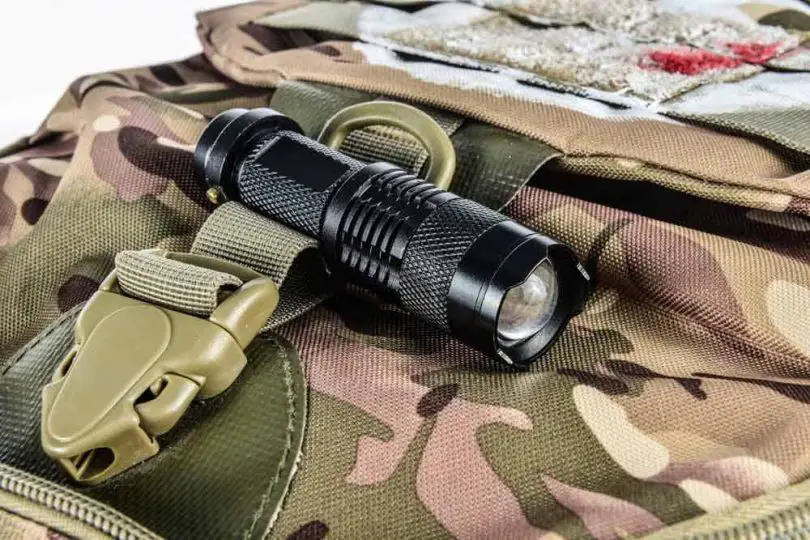Although tactical flashlights are usually used by the military, law enforcement, and emergency services, they have become very popular among the common people these days.
Mainly used in situations that involve rough handling, they are made super sturdy and durable.
Here is everything you need to know about tactical flashlights and if you should have one for safety.
What Is a Tactical Flashlight?

Tactical flashlights are used by law enforcement officers, marksmen, or military professionals.
They need these types of flashlights to identify targets in low-light conditions. These are usually mounted to a weapon while shooting in the dark or a low-light environment.
Usually, they are pocket-sized, emit brighter light than regular EDC flashlights, and are created with aerospace and weapon-grade aluminum for higher longevity.
Some of these flashlights can be used with infrared filters with night vision devices (NVDs).
The tactical flashlight helps illuminate or mark objects and areas under surveillance by only those who wear night vision.
It is a standard practice for the military to use tactical flashlights with laser sighting for weapons.
These flashlights are designed for high-stress action since they are most of the time mounted to shotguns or M4/AR15 platforms.
They are waterproof to quite an extent. For a better grip and handling, they usually have textured grips and anti-roll profiles.
Apart from that, so many Americans own them for self-defense or just for the feel-good factor of ownership.
They can even be carried in air transport as there are no restrictions imposed on them.
When to Use a Tactical Flashlight?
1. Illumination: You might find tactical flashlights handy in dark environments and complete blackouts.
Illuminating quite a great distance and focusing on objects or places is easy with these lights.
If any time your car breaks down, you can use the flashlight to look into your engine or even seek help from around you.
2. Signaling device: If you are out camping and lose contact with your group, signaling them with the flashlight grabs attention faster than screaming or making noise.
3. Striking tool: For beginners, tactical flashlights are intensely bright.
By intensely bright I mean your brain will ache if you look at them directly.
So this helps it to become a great distracting tool.
If you feel threatened by someone, just flashing the light on their face will blind them for a while, helping you to get away or move to a suitable position.
Quite a few tactical flashlights also have bezel edges which can be a good tool to break a window or even crack a skull, making it an effective defensive tool although breaking windows is not encouraged.
4. For self-defense: If you own a gun for defense, chances are that you‘ve already mounted one because even the FBI states that people usually use their weapons more in low light conditions than in broad daylight.
There also exists the problem that since these flashlights have to be pointed at the archery target while shooting, this can be unsafe as at a low light environment you may point at a non-threat otherwise.
Learning some techniques like the following will be helpful.
5. Starting a fire with a flashlight: By using the mirrored cup in the flashlight, fire can be lit. The mirror acts as a magnifying glass by focusing light to produce heat.
Place some fine tinder or fluffy plant-based fiber on the mirrored cup by removing the light bulb and putting it under direct sunlight.
It will smoke after some time and you will have to blow into the fuming tinder and the fire will slowly form.
Another method is to use the flashlight battery and steel wool. The steel wool must be kept dry. By using a 3-volt battery fire can be ignited into the steel wool.
The pros of this technique are that different types of steel wool can be used in the process.
The cons are that the steel wool won’t work if it is wet and a dead battery can’t be used either.
Also, both these materials have to be stored apart as they can easily catch fire while commuting. It is difficult to find good-grade steel wool outside of hardware stores.
6. As a utility tool: These are sturdy and durable.
For example, a Maglite can work as a weapon due to its long handle and thick hard exterior.
Due to the presence of serrated edges, these can be used to break the window of a car and get out during a rush.
How to Use a Tactical Flashlight?
Chapman technique: in this technique, the flashlight is held like a sword and the flashlight-holding hand rests next to it.
This method is more appropriate for older flashlights with the switch on top rather than modern tactical flashlights.
Harries technique: grab the flashlight with your right hand in an “ice pick” grip if you are a right-handed shooter and operate the pressure switch on the light with your left thumb.
The way you’re holding the flashlight should allow you to strike down with significant force.
Neck index: the light has to shine from where your eyes are looking in this technique. The flashlight has to be beside your cheek, away from the weapon-holding hand.
This can be risky as the bad guy will want to shoot where they see the light and in this case, it is just beside your head.
FBI technique: this technique keeps the light far away from your head as the light is placed below and a bit far from your body.
So the bad guy may hit any nonvital organ like your hand.
However, your hand holding the flashlight must be placed far away from the vital organs to protect them.
Sure fire technique: you have to hold the torch between your index finger and forefinger like a syringe. The rest of the hand provides good cupping around the pistol.
It provides a good grip for recoiling and more stability.
But if the flashlight is larger in this case, it will not provide the blinding effect of a smaller flashlight.
What Makes a Good Tactical Flashlight?
In the USA, according to ANSI in 2009 voluntary standards have defined conditions for total light output, the distance of work, the intensity of the beam, water resistance, battery run time, and impact.
Features:
1. High output brightness: the higher the number of lumens there are, the brighter it will be. This will also consume more battery.
Tactical flashlights have lumen output setting choices.
Some help you to buy time in emergencies as they have the strobe feature which confuses or obstructs attackers.
Other things to consider for lumens are whether the flashlight has multiple modes, the flashlight’s beam distance, and also how long the light will work at its highest brightness setting.
2. Type of bulb: good tactical flashlights have LED bulbs and the good quality ones are pricey.
Never buy a flashlight without an LED bulb because they run out very quickly and require frequent changing.
3. Power sources: the usual options are rechargeable batteries and disposable batteries. Try to choose batteries even in size and not too fancy as they can be difficult to replace.
Rechargeable batteries over the years lose the capacity to hold a decent amount of charge.
For these batteries, you will also need additional battery charging kits, USB outputs, micro USB cables, and USB power adapters.
4. Tactical factors (depends on the type of use but other than that):
-the lighter the weight, the better.
– For night time, a black finish is the best.
– find waterproof ones with weather resistance
– Plastic lenses are lighter and have versatile uses but it’s best to go for scratch-resistant ones
How Many Lumens for a Tactical Flashlight?
The number of lumens required depends upon the purpose.
Currently, you can purchase models of tactical flashlights which have 100-watt light bulbs and radiate about 1,750 lumens.
If there is no financial constraint, a whopping 4,100 lumens can be bought which is sufficient to blind a person for a long while even in broad daylight.
Such high-powered flashlights have to be used carefully as they can cause irreparable retina damage to non-targeted individuals.
For purposes like sailing, fishing, climbing, hiking, etc. 200 to 500 lumens are sufficient.
For industrial purposes like security, tactical use, camping, etc.600 to 1000 lumens are needed.
Outdoor lighting, search and rescue, any type of hunting, and outdoor recreational activities in large properties require more than 1000 lumens.
FAQs
1. What tactical flashlight does the military use?
Ans: The Surefire Sidekick 300 is a well-trusted name due to its excellent built quality, high power, superior optics, micro USB charging facility, and versatility. Battery charges within 4 to 5 hours, however, there is no charging indicator.
2. Can 1000 lumens blind you?
Ans: It most likely won’t blind them but can cause mild irritation and slightly affect their vision
3. Are tactical flashlights legal in the USA?
Ans: Yes, as they have all the qualities of a regular flashlight. They also have added features like brighter light/longevity and can be used for multiple purposes like self-defense.
4. How many lumens do you need to blind an attacker?
Ans: 100 lumens to blind the person for a few minutes at night time. 300 and above lumens are required for daylight.
5. Are tactical flashlights effective?
Ans: Tactical flashlights are effective as self-defense tools. They distract attackers with powerful light, optically confuse them, and can be used as a blunt force weapon for self-defense.
Also used by mounting to a weapon like scopes or for everyday carrying.









Leave a Comment